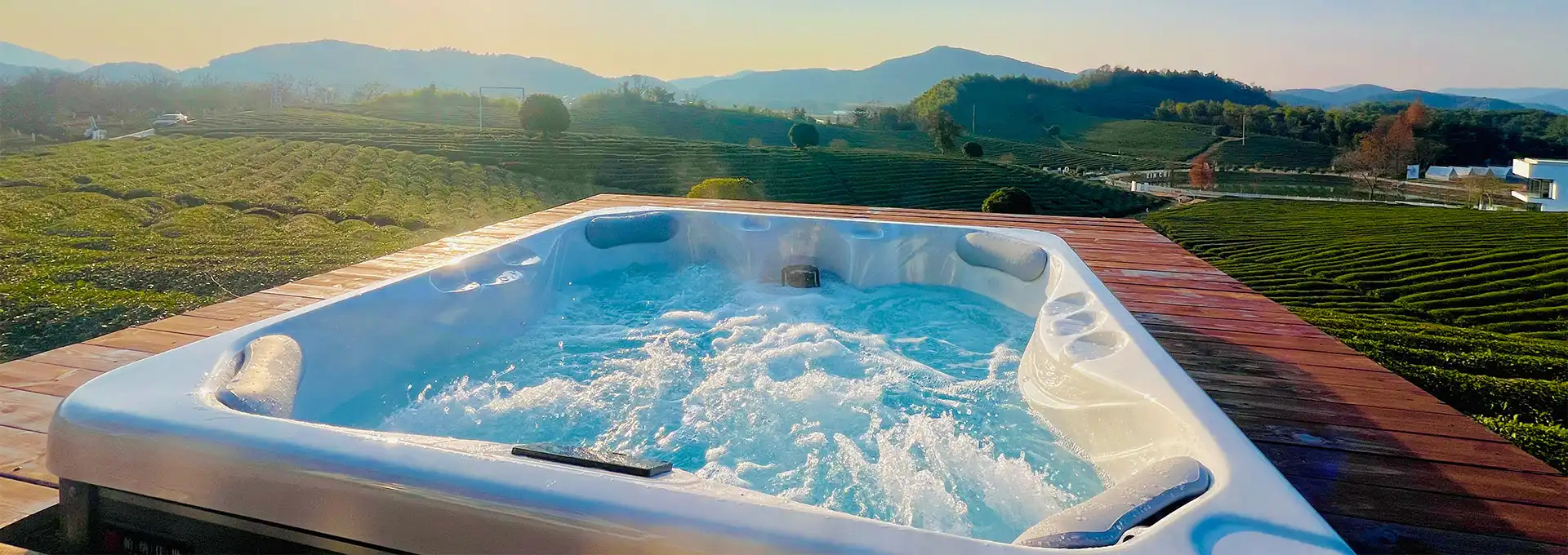Is a Hot Tub Good for COVID Recovery?
2024-08-15 13:40:43
The COVID-19 pandemic has led many people to explore various methods for managing symptoms and supporting recovery. One question that has arisen is whether using a hot tub can be beneficial for those recovering from COVID-19. While hot tubs are often associated with relaxation and potential health benefits, it's important to consider their role in the context of COVID-19 recovery carefully. This article will explore the potential benefits and risks of using a hot tub during COVID-19 recovery, as well as addressing some common questions about hot tub use in general.
What are the benefits of a 5-person hot tub?
Hot tubs, particularly those designed for 5 people, offer a range of potential benefits that can contribute to overall well-being and relaxation. These benefits extend beyond mere leisure and can have positive impacts on both physical and mental health.
One of the primary advantages of a 5-person hot tub is its ability to promote relaxation and stress relief. The warm water and jet massages can help soothe tense muscles and reduce overall body tension. This relaxation effect can be particularly beneficial for those recovering from illness or dealing with the stress of daily life. The combination of heat and buoyancy in a hot tub can also help to improve circulation, which may aid in reducing inflammation and promoting healing throughout the body.
Another significant benefit of a 5-person hot tub is its potential to alleviate certain types of pain. The warm water and hydrostatic pressure can help to reduce joint pain and stiffness, making it a popular option for those with arthritis or other chronic pain conditions. The massaging jets can also target specific areas of muscle tension, providing relief from back pain, neck pain, and other musculoskeletal discomforts.
Hot tubs can also contribute to better sleep quality. The relaxation induced by a warm soak before bedtime can help prepare the body for sleep, potentially leading to more restful and restorative sleep patterns. This improved sleep quality can be particularly beneficial for those recovering from illness or dealing with stress-related sleep disturbances.
Furthermore, a 5-person hot tub provides an excellent opportunity for social interaction and bonding. Spending time with family or friends in a relaxing environment can foster closer relationships and promote mental well-being. This social aspect can be especially valuable during recovery periods when individuals may feel isolated or in need of emotional support.
It's important to note, however, that while these benefits can be significant, they should be considered in the context of an individual's overall health status and any specific medical conditions. In the case of COVID-19 recovery, it's crucial to consult with a healthcare provider before using a hot tub to ensure it's safe and appropriate for your specific situation.
How often should you use a 5-person hot tub?
The frequency of hot tub use can vary depending on individual circumstances, health conditions, and personal preferences. However, there are some general guidelines to consider when determining how often to use a 5-person hot tub.
For most healthy adults, using a hot tub 2-3 times per week for 15-30 minutes per session is considered safe and potentially beneficial. This frequency allows for regular relaxation and potential health benefits without overexposure to heat or chemicals. However, it's important to listen to your body and adjust usage accordingly. Some people may find daily use beneficial, while others might prefer less frequent sessions.
When considering hot tub use during COVID-19 recovery, it's crucial to be more cautious. The frequency of use should be determined in consultation with a healthcare provider, taking into account the individual's recovery progress, any lingering symptoms, and overall health status. In general, it may be advisable to start with less frequent and shorter sessions, gradually increasing as recovery progresses and if no adverse effects are experienced.
It's also important to consider the maintenance aspect of frequent hot tub use. A 5-person hot tub requires regular cleaning and chemical balancing to ensure a safe and hygienic environment. More frequent use may necessitate more frequent maintenance, including water testing, chemical adjustments, and cleaning of filters and surfaces.
The time of day for hot tub use can also impact its effects and safety. Many people find evening use most beneficial, as it can promote relaxation and better sleep. However, it's generally recommended to avoid hot tub use immediately before bedtime, as the drop in body temperature after exiting the hot tub can interfere with sleep onset.
Hydration is another crucial factor to consider with regular hot tub use. The heat and steam can lead to increased fluid loss through sweating, so it's important to drink plenty of water before, during, and after hot tub sessions to prevent dehydration.
Lastly, it's important to be aware of any personal health conditions that might affect safe hot tub use. Certain conditions, such as cardiovascular issues, skin sensitivities, or compromised immune systems, may require limiting hot tub use or avoiding it altogether. Always consult with a healthcare provider if you have any concerns about how often you should use a hot tub, especially in the context of COVID-19 recovery.
What is the ideal temperature for a 5-person hot tub?
The ideal temperature for a 5-person hot tub can vary depending on personal preference and health considerations, but there are some general guidelines to ensure both comfort and safety. Understanding the optimal temperature range is crucial, especially when considering hot tub use during COVID-19 recovery or for general health purposes.
The U.S. Consumer Product Safety Commission recommends that hot tub water temperatures never exceed 104°F (40°C). This upper limit is set to prevent hyperthermia, a dangerous overheating of the body that can lead to various health issues. However, most hot tub users find temperatures between 100°F and 102°F (37.8°C to 38.9°C) to be the most comfortable and beneficial range.
At these temperatures, the hot tub can provide the desired relaxation and potential therapeutic effects without putting undue stress on the body. The warm water can help to dilate blood vessels, improve circulation, and relax muscles, potentially aiding in recovery and overall well-being.
For those recovering from COVID-19 or other illnesses, it may be advisable to start with slightly lower temperatures, perhaps around 98°F to 100°F (36.7°C to 37.8°C). This lower range can still provide comfort and potential benefits while reducing the risk of overheating or exacerbating any lingering symptoms. As recovery progresses, the temperature can be gradually increased if desired and if no adverse effects are experienced.
It's important to note that individual tolerance to heat can vary. Factors such as age, overall health status, and any existing medical conditions can affect how a person responds to different hot tub temperatures. For example, pregnant women, young children, and individuals with certain health conditions may need to use lower temperatures or avoid hot tub use altogether.
The duration of hot tub use also plays a role in determining the ideal temperature. At higher temperatures, it's generally recommended to limit sessions to 15-20 minutes to prevent overheating. Lower temperatures may allow for slightly longer sessions, but it's always important to listen to your body and exit the hot tub if you feel uncomfortable, dizzy, or overheated.
Environmental factors can also influence the ideal hot tub temperature. In warmer climates or during summer months, slightly lower temperatures may be more comfortable and safer. Conversely, in colder weather, users might prefer slightly higher temperatures for comfort.
For those using a hot tub as part of a recovery or wellness routine, it's crucial to pay attention to how your body responds to different temperatures. Start at a lower temperature and gradually increase it to find your personal comfort zone. Always prioritize safety over pushing temperature limits.
Lastly, it's worth noting that the temperature of a 5-person hot tub should be consistent for all users. While individual preferences may vary, it's important to find a temperature that is safe and comfortable for everyone using the hot tub. This is particularly important in the context of COVID-19 recovery, where users may have different levels of heat tolerance or recovery progress.
In conclusion, while hot tubs can offer various potential benefits, their use during COVID-19 recovery should be approached with caution. The warm water and relaxation provided by a hot tub may help alleviate some symptoms and promote overall well-being, but it's crucial to consult with a healthcare provider before incorporating hot tub use into your recovery routine. Factors such as frequency of use, temperature, and individual health status all play important roles in determining the safety and efficacy of hot tub use during recovery. By understanding these factors and following appropriate guidelines, individuals can make informed decisions about whether and how to use a hot tub as part of their COVID-19 recovery journey.
If you want to get more information about this product, you can contact us at info@iparnassus.com!
References:
1. Centers for Disease Control and Prevention. (2021). Water and COVID-19 FAQs.
2. Mayo Clinic. (2022). Hot tub safety: Tips to avoid infection and injury.
3. American Journal of Physiology. (2019). Passive heat therapy improves endothelial function, arterial stiffness and blood pressure in sedentary humans.
4. Journal of Athletic Training. (2017). Effectiveness of Water Immersion on Postmatch Recovery in Elite Professional Footballers.
5. Arthritis Foundation. (2021). Warm Water Works Wonders on Pain.
6. Sleep Foundation. (2022). How to Use a Hot Tub Before Bed.
7. U.S. Consumer Product Safety Commission. (2021). Safety Barrier Guidelines for Residential Pools and Spas.
8. International Journal of Environmental Research and Public Health. (2018). Balneotherapy and Human Immune Function in the Era of COVID-19.
9. World Health Organization. (2022). Water, sanitation, hygiene, and waste management for SARS-CoV-2, the virus that causes COVID-19.
10. Journal of Physiological Anthropology. (2018). Effects of bathing on body temperature, heart rate, and oxygen consumption.
Send Inquiry
Related Industry Knowledge
- Can You Go in a Hot Tub with a Sunburn?
- How to Clear Up a Hot Tub?
- How Important is a Hot Tub for a Vacation Rental?
- Do Hot Tubs Dry Out Your Skin?
- What is a Wet End in a Swim Spa?
- How long should you stay in a cold plunge tub?
- How to Fix a Cloudy Hot Tub?
- How much is a large hot tub?
- Can Getting in a Hot Tub Clear Your Sinus?
- How much does a large hot tub weigh?



